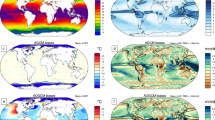Abstract
Effects of time-dependent large-scale forcing, solar zenith angle, and sea surface temperature on time-mean rainfall during the Tropical Ocean Global Atmosphere Coupled Ocean–Atmosphere Response Experiment (TOGA COARE) are examined through a partitioning analysis of a series of sensitivity cloud-resolving model experiment data based on surface rainfall budget. The model is forced by time-dependent large-scale forcing (LSF), solar zenith angle (SZA), and sea surface temperature (SST) in the control experiment and is forced only by either time-dependent LSF, SZA, or SST while others are replaced with their time averages in the sensitivity experiments. The rainfall associated with water vapor divergence and local atmospheric drying and hydrometeor loss/convergence has the largest contribution to total rainfall among eight rainfall types. The largest rainfall contribution is increased in the simulations where either time-dependent LSF, SZA, or SST is replaced with its average, whereas it is decreased in the simulation where COARE-derived large-scale vertical velocity is replaced with zero vertical velocity. The contribution of the rainfall associated with water vapor convergence to total rainfall is decreased in the simulations with time-mean LSF, SZA, and SST, whereas it is increased in the simulation without large-scale vertical velocity.




Similar content being viewed by others
References
Chou M-D, Suarez MJ (1994): An efficient thermal infrared radiation parameterization for use in general circulation model. NASA Tech Memo 104606, vol 3, NASA/Goddard Space Flight Center, Code 913, Greenbelt, MD 20771
Chou M-D, Kratz DP, Ridgway W (1991) Infrared radiation parameterization in numerical climate models. J Clim 4:424–437
Chou M-D, Suarez MJ, Ho C-H, Yan MM-H, Lee K-T (1998) Parameterizations for cloud overlapping and shortwave single scattering properties for use in general circulation and cloud ensemble models. J Atmos Sci 55:201–214
Cui X, Li X (2006) Role of surface evaporation in surface rainfall processes. J Geophys Res, 111. doi:10.1029/2005JD006876
Gao S, Li X (2008) Cloud-resolving modeling of convective processes. Springer, Berlin, pp 206
Gao S, Li X (2010a) Effects of time-dependent large-scale forcing, solar zenith angle, and sea surface temperature on time-mean tropical rainfall processes. Meteor Atmos Phys 106:95–105
Gao S, Li X (2010b) Precipitation equations and their applications to the analysis of diurnal variation of tropical oceanic rainfall. J Geophys Res 115:D08204. doi:10.1029/2009JD012452
Gao S, Cui X, Zhou Y, Li X (2005) Surface rainfall processes as simulated in a cloud resolving model. J Geophys Res 110:D10202. doi:10.1029/2004JD005467
Gao S, Zhou Y, Li X (2007) Effects of diurnal variations on tropical equilibrium states: A two-dimensional cloud-resolving modeling study. J Atmos Sci 64:656–664
Krueger SK, Fu Q, Liou KN, Chin H-NS (1995) Improvement of an ice-phase microphysics parameterization for use in numerical simulations of tropical convection. J Appl Meteor 34:281–287
Li X, Sui C-H, Lau K-M, Chou M-D (1999) Large-scale forcing and cloud-radiation interaction in the tropical deep convective regime. J Atmos Sci 56:3028–3042
Li X, Sui C-H, Lau K-M (2002) Precipitation efficiency in the tropical deep convective regime: A 2-D cloud resolving modeling study. J Meteor Soc Jpn 80:205–212
Lin Y-L, Farley RD, Orville HD (1983) Bulk parameterization of the snow field in a cloud model. J Clim Appl Meteor 22:1065–1092
Rutledge SA, Hobbs PV (1983) The mesoscale and microscale structure and organization of clouds and precipitation in midlatitude cyclones. Part VIII: a model for the “seeder-feeder” process in warm-frontal rainbands. J Atmos Sci 40:1185–1206
Rutledge SA, Hobbs PV (1984) The mesoscale and microscale structure and organization of clouds and precipitation in midlatitude cyclones. Part XII: a disgnostic modeling study of precipitation development in narrow cold-frontal rainbands. J Atmos Sci 41:2949–2972
Shen X, Wang Y, Zhang N, Li X (2010) Precipitation and cloud statistics in the deep tropical convective regime. J Geophys Res 115:D24205. doi:10.1029/2010JD014481
Soong ST, Ogura Y (1980) Response of trade wind cumuli to large-scale processes. J Atmos Sci 37:2035–2050
Soong ST, Tao WK (1980) Response of deep tropical cumulus clouds to mesoscale processes. J Atmos Sci 37:2016–2034
Sui C-H, Lau K-M, Tao W-K, Simpson J (1994) The tropical water and energy cycles in a cumulus ensemble model. Part I: equilibrium climate. J Atmos Sci 51:711–728
Tao W-K, Simpson J (1993) The Goddard Cumulus Ensemble model. Part I: model description. Terr Atmos Ocean Sci 4:35–72
Tao W-K, Simpson J, McCumber M (1989) An ice-water saturation adjustment. Mon Wea Rev 117:231–235
Tao W-K, Simpson J, Sui C-H, Ferrier B, Lang S, Scala J, Chou M-D, Pickering K (1993) Heating, moisture and water budgets of tropical and midlatitude squall lines: comparisons and sensitivity to longwave radiation. J Atmos Sci 50:673–690
Weller RA, Anderson SP (1996) Surface meteorology and air-sea fluxes in the western equatorial Pacific warm pool during TOGA COARE. J Clim 9:1959–1990
Zhou Y, Li X (2009) Sensitivity of convective and stratiform rainfall to sea surface temperature. Atmos Res 92:212–219
Acknowledgments
The authors thank Prof. M. Zhang, the State University of New York at Stony brook, for his TOGA COARE forcing data and the two anonymous reviewers for their constructive comments. This work was supported by the National Key Basic Research and Development Project of China No. 2009CB421505, the National Natural Sciences Foundation of China under the Grant No. 40930950 and 41075043.
Author information
Authors and Affiliations
Corresponding author
Additional information
Responsible editor: J. Fasullo.
Rights and permissions
About this article
Cite this article
Gao, S., Li, X. Effects of time-dependent large-scale forcing, solar zenith angle, and sea surface temperature on time-mean rainfall: a partitioning analysis based on surface rainfall budget. Meteorol Atmos Phys 113, 1–10 (2011). https://doi.org/10.1007/s00703-011-0139-7
Received:
Accepted:
Published:
Issue Date:
DOI: https://doi.org/10.1007/s00703-011-0139-7



